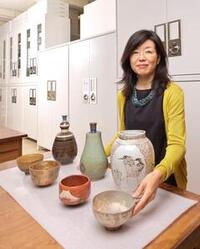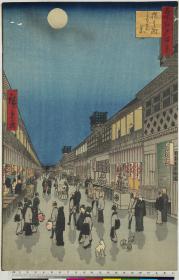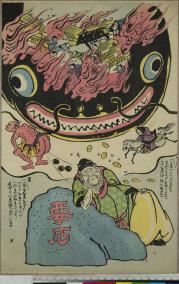-
研究者インタビュー>武末明子 (ロイヤルオンタリオ博物館 学芸員) ※本文は英語です2023年10月27日(金)
関連記事はこちら → ロイヤル・オンタリオ・ミュージアム所蔵の浮世絵版画作品(4233点)と古典籍(74点)が公開されました
関連データベースはこちら → Royal Ontario Museum Ukiyo-e Database / Royal Ontario Museum Japanese Old Books Database
Background:
Dr. Akiko Takesue joined the Royal Ontario Museum (ROM) in 2021 as the Bishop White Committee Associate Curator of Japanese Art & Culture, an endowed position, and is in charge of researching and developing the ROM's collection of Japanese art and culture that comprises approximately 10,000 objects.
Dr. Takesue holds a doctorate in Art History from York University and Master's degrees from the University of Toronto and the University of New South Wales. In addition to the ROM, she has broad curatorial experience at the Montreal Museum of Fine Arts, the National Gallery of Art in Washington, DC, and the Art Gallery of New South Wales in Sydney, Australia.Dr Takesue, thank you very much for your time today. What sparked your interest in Japanese art history?
 Takesue: It is a long story since I left Japan almost 25 years ago. When I was younger and living in Japan, I was more interested in Western than Japanese art. Hence, I went to Sydney, Australia, to study art. At that time, I had the idea to work in an art gallery dealing with Western contemporary art.
Takesue: It is a long story since I left Japan almost 25 years ago. When I was younger and living in Japan, I was more interested in Western than Japanese art. Hence, I went to Sydney, Australia, to study art. At that time, I had the idea to work in an art gallery dealing with Western contemporary art.Then, while I was doing an internship at the Art Gallery of New South Wales in Sydney under a Japanese curator, I discovered the beauty and excitement of studying and dealing with Japanese art. Interestingly, I realized the Japanese art collection there was different from what I thought of Japanese art, which was sort of a trigger for me to research the global circulation of Japanese art since the Meiji period.
As the Japanese collections overseas consist of many export arts, i.e., made in Japan but only for the Western market, I discovered many things I never knew about when I was in Japan. So, I became fascinated with the fact that Japanese art in Sydney was indeed different from my understanding of Japanese art. This interest continues even now.
I also investigated in my PhD dissertation how objects stay the same while their meanings shift from time to time, place to place.
How did you first connect with the Art Research Center (ARC)?
Takesue: It was through my predecessor, Dr. Rosina Buckland, who is now at the British Museum. In 2020, she started the digitization project of the ROM's Japanese art collection with Prof. Akama whom I met when he and his team was taking photographs of the collection. So, after Dr. Buckland left in 2021, I continued to complete this project, and I feel fortunate and grateful that she started it.
Comprising approximately 10,000 objects, the Japanese art collection of the ROM is the largest of its kind in Canada. Considered to be particularly comprehensive is the ukiyo-e print collection. What do you find fascinating about it and why?
Takesue: Over 2,000 ukiyo-e prints and surimono of Sir Byron Edmund Walker, one of the founders and the first chairman of the ROM, were bequested to the ROM in 1926, which became the core of our entire Japanese print collection.
The ROM already had some woodblock prints since 1916, but at that time, no one knew much about Japanese art at the museum. With the Walker Collection and the earlier prints, our print collection expanded, comprising over 4,000 prints today.
Furthermore, there is a variety in the genres of the prints. The ROM's collection consists of actor prints, prints of beautiful women, landscape prints, including those of Hokusai and Hiroshige, as well as prints from the Meiji period and war prints. So not only the sheer number of prints but the range of subjects make our collection quite valuable and unique.
For example, we have an almost complete set of Hiroshige's Meisho Edo Hyakkei (One Hundred Famous Views of Edo). It may not be well-known, but our set is almost like a 'first edition'. 'First edition' may be a tricky term, but our set is in a very good condition, and you can see the highly skilled printing techniques used. While everyone knows about the first edition at the Brooklyn Museum, hardly anybody knows about our set.
When I recently went to the Brooklyn Museum, I compared their set with printouts of some of our prints with the curator there, and we realized that both of our sets are almost identical. So, I was glad I could confirm that our set is also a high-quality series.
You also have a rare collection of Ogata Gekko prints. What are your thoughts on this collection?
Takesue: This collection is very unique, too. Although Gekko was quite well-known in his lifetime in the Meiji period and produced many prints, paintings, and book illustrations, he became somewhat of a forgotten artist.
A Toronto-based collector and former law librarian of York University, Balfour Halévy, accumulated over 600 of Gekko's works and donated the whole collection to the ROM in 2016. According to him, another extensive collection of Gekko prints exists in New Zealand. Since these two collections seem to be the only comprehensive collections dedicated to Gekko outside of Japan, we are very fortunate to have one of them at the ROM.
In June this year, 4,233 ukiyo-e prints and 74 old Japanese books from the ROM's collection were released in the ARC portal database. What is the significance of this database?
Takesue: The contents and quality of our print collection are good, however, not many people, including researchers, seem to be aware that we have such a comprehensive collection of prints. So, we are grateful for this ARC digitization project to make our collection available to researchers and the public for their studies, research, and pleasure. Otherwise, those prints remain just hidden in our storage. Except for a few notable research efforts, the whole collection has not been studied extensively.
Our goal is that many scholars and researchers will take note of the prints in the ROM's collection so we can contribute to the development of ukiyo-e research. The release of our collection marks a significant starting point.
What are your thoughts on the importance of digitization for museums, and how does it play a part in your plans at the ROM?
Takesue: Digitization of the collection is crucial to provide the public access to what we have. The ROM is a huge museum with 13 million objects in total in its collections. So, I believe that anyone can find at least one favorite object.
We try to exhibit as many in the museum as possible, but space is limited. Only less than 5% of our collection is publicly displayed. The rest is in our storage, with many objects never being on public view.
While, as a museum curator, I believe in the power of objects when you see them with your eyes, if a collection is available online, people have another way to enjoy the collection. Availability and accessibility are crucial particularly since we have no permanent Japanese gallery at the ROM right now.
I have recently completed an online exhibition on catfish prints. COVID has, in a way, accelerated the development of virtual channels. Digitization has become essential to showcase the Japanese collection at the ROM.
Finally, could you share a few of your personal favorites within the ROM's ukiyo-e print collection?
Takesue: I like ukiyo-e prints with some layers of meaning behind them, for instance, parodies (mitate-e) or complex ideas, which I realized when I did the online exhibition on the catfish prints. They are not just funny prints but encompass emotions and thoughts of people about society at that time. This is why I am fascinated with this kind of print.
Hiroshige's Meisho Edo Hyakkei (One Hundred Famous Views of Edo) is also one of my favorites, mainly because of its composition. Hiroshige uses very striking, innovative perspectives of having something huge at the front with other elements kept smaller at the back, which, at that time, was quite innovative and a reason why Western artists, including Impressionist artists were so fascinated with the Japanese prints.
Images credit: Courtesy of ROM (Royal Ontario Museum), Toronto, Canada. ©ROM
(This interview was conducted by Yinzi Emily Li)
Related article → The Royal Ontario Museum (ROM) Collection of Ukiyo-e Prints and Japanese Old Books has been released
Related databases → Royal Ontario Museum Ukiyo-e Database / Royal Ontario Museum Japanese Old Books Database















